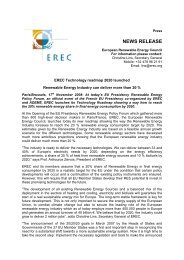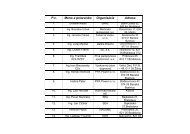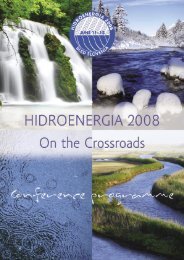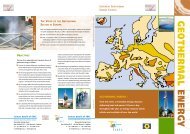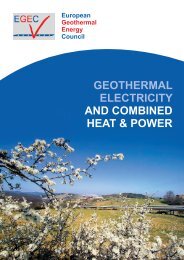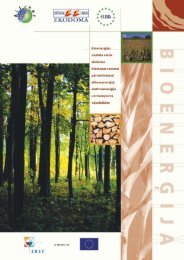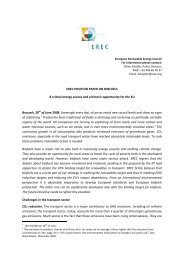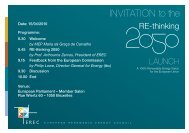CTO Assessment - European Commission
CTO Assessment - European Commission
CTO Assessment - European Commission
Create successful ePaper yourself
Turn your PDF publications into a flip-book with our unique Google optimized e-Paper software.
The Italian<br />
Sustainable Islands<br />
Programme<br />
Contacts: Gianni Silvestrini • Ministero dell’Ambiente<br />
Servizio Inquinamento Atmosferico e Rishi Industriali • via Cristoforo Colombo 44<br />
00147 Rome • Italy • Tel +39 06 57225323 • Fax +39 06 57225371<br />
E-mail: gamberale.mario@minambiente.it<br />
Main aims and motivations<br />
In the last 20 years there have been several<br />
attempts to introduce renewable energies<br />
in Italian small islands, with limited<br />
results. Rather then a problem of funding,<br />
the reasons has been the combination of<br />
two important obstacles: the regulatory<br />
framework for the production and distribution<br />
of electricity and the obstacles posed<br />
by authorities (Soprintendenze) that defend<br />
the landscape.<br />
The Ministry of Environment has decided<br />
to launch a sustainable energy program<br />
for the small islands to try to overcome<br />
these obstacles and foster the large scale<br />
diffusion of renewable sources of energy.<br />
The expected results are a greater<br />
sensitisation towards these less polluting<br />
forms of energy , more rapid concentration<br />
of different funds in this area , accelerated<br />
establishment of new rules for local<br />
electric producers and finally reduction of<br />
the gap between the culture of the Authorities<br />
in defence of landscape and the approach<br />
of the installers of renewable energy<br />
technologies.<br />
The project<br />
The programme foresees the realisation<br />
of environmental valorisation actions to<br />
be realised in Italian Small Islands that<br />
are natural parks.<br />
For the realisation of the programme a<br />
Protocol has been signed by the former<br />
Minister of Environment and the Association<br />
of small islands, ANCIM.<br />
The first operational step toward the application<br />
of the Protocol has been the<br />
launching of a public tender for the local<br />
administration of Small Island to submit<br />
energy and mobility plans (deadline 15<br />
October 2001).<br />
Projects will be judged by a jury that will<br />
select the best projects and finance them<br />
to a maximum of 1.7 million Euro per<br />
project for the energy projects and to a<br />
maximum of 1.25 million Euro per project<br />
for mobility.<br />
A fund of 2.4 M euro will be given to a<br />
couple of islands that will be chosen among<br />
all the municipalities that will prepare feasibility<br />
studies to improve sustainable mobility<br />
in their areas.<br />
The answer to the call has been wide. Most<br />
islands are interested both in renewable<br />
energies and mobility.<br />
As regards the energy plans the islands<br />
are requested to follow a scenario procedure<br />
focusing firstly on energy saving measures<br />
and solar thermal systems and secondly<br />
in renewable energies application for<br />
electricity production.<br />
Enabling factors<br />
The tourist nature of the island gives a<br />
unique opportunity of applying direct solar<br />
technologies: the seasonal nature of the<br />
load curve meets the solar insulation curve<br />
availability much better than any other seasonal<br />
load curve in the continent. The first<br />
result of this is that the ratio between the<br />
energy actually used and the total energy<br />
produced is much higher than usual.<br />
The Programme will offer to a large number<br />
of islands a unique possibility to develop<br />
specific feasibility studies on the<br />
large-scale introduction of renewable energies<br />
and will enable a couple of them to<br />
begin the transition toward self-sufficiency.<br />
Challenges<br />
Most of the island generation systems are<br />
managed by small electricity distribution<br />
companies. Only 8 out of 45 are ENELowned<br />
(Panarea, Salina, Capraia,<br />
Stromboli, Vulcano, Alicudi, Filicudi,<br />
Ventotene). Island utilities are quite reluctant<br />
to change the existing situation for<br />
several reasons:<br />
They work in a monopoly condition.<br />
The extra cost of local energy production<br />
is totally covered by the government.<br />
This mechanism produces high energy consumption<br />
and inefficiency and it is the reason<br />
why distributors are definitely against<br />
a change of scenario particularly if energy<br />
saving measures and renewable energies<br />
are being proposed.<br />
Summary of characteristics of the <strong>CTO</strong>´S projects:<br />
Proposed technologies<br />
Financial data<br />
Island Wind(kW) SPV(kW) STH(m3) Energy Saving Total investment(Euro) Funding(Euro) Co-funding(%)<br />
Pantelleria<br />
660<br />
100<br />
758<br />
URE<br />
2,848,715<br />
1,137,339<br />
40<br />
Pantelleria<br />
660<br />
100<br />
758<br />
URE<br />
2,848,715<br />
1,137,339<br />
40<br />
Ventotene<br />
-<br />
126<br />
494<br />
Lamps, pumps<br />
1,766,799<br />
1,062,842<br />
60<br />
Gorgona<br />
50<br />
-<br />
455<br />
Boilers, lamps<br />
1,152,758<br />
406,749<br />
35<br />
Giglio<br />
535<br />
14<br />
346<br />
Pumps<br />
1,726,960<br />
465,552<br />
27<br />
Panarea<br />
study<br />
33<br />
60<br />
-<br />
363,415<br />
205,252<br />
56<br />
TOTAL<br />
1,245<br />
273<br />
2,113<br />
7,858,646<br />
3,277,734<br />
<strong>CTO</strong> - Showcase<br />
65



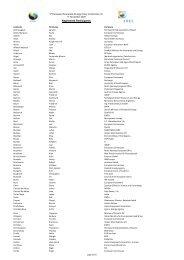
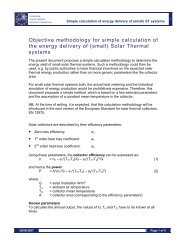
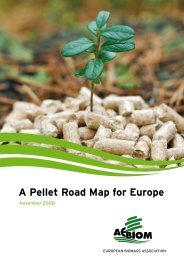
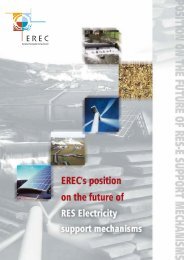

![Energy [R]evolution - Greenpeace](https://img.yumpu.com/47174859/1/184x260/energy-revolution-greenpeace.jpg?quality=85)
